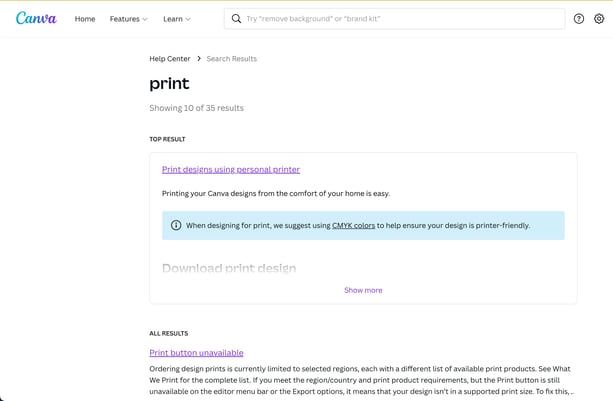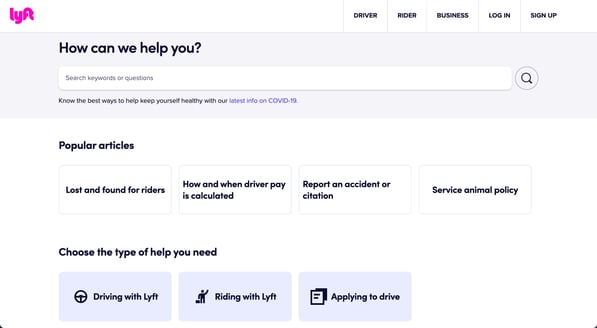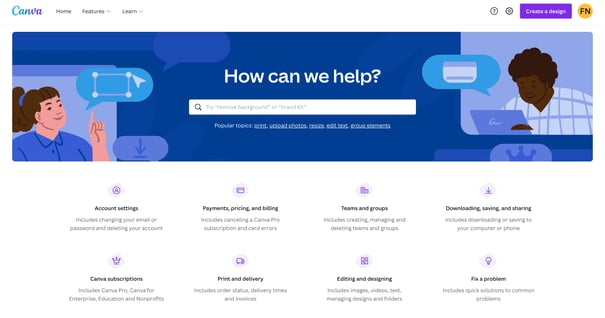More than 69% of consumers prefer to solve issues on their own, and 63% almost always start with a search through a company’s online resources before ever turning to a support rep.

When customers would rather search their questions and get an immediate solution than pick up the phone, you need to speak to their desire, and the best way to do so is through a knowledge base.
Read on to learn more about knowledge bases, why they’re important, and discover high-quality examples that you can use for inspiration. If you already know what you need, jump there with this table of contents:
- Knowledge Base Definition
- Why You Need a Knowledge Base
- How to Build a Knowledge Base
- What type of data is included in a knowledge base?
- Examples of Knowledge Bases
Knowledge Base Definition
A knowledge base is a centralized database for spreading information and data. Knowledge bases support collecting, organizing, retrieving, and sharing knowledge.
There are two main forms of knowledge bases: machine-readable and human-readable.
Machine-readable knowledge bases store data that can only be analyzed by artificial intelligence systems. These solutions are interpreted and deducted by machines and, thus, are less interactive. Human-readable knowledge bases store documents and physical texts that can be accessed by humans. They are more interactive and hands-on but require time-consuming prompting to gain solutions.
What type of data is included in a knowledge base?
All knowledge bases share valuable information with customers and prospects, but the type of data and information you include in it depends on your business’ purpose for creating one. Common types of data included in a knowledge base are:
- Directions and tips for using your products and services
- Answers to FAQs
- Content you’ve created that can provide in-depth solutions
- Video demonstrations
- Company information
- Knowledge on different business departments
Some businesses also create content that is helpful for general consumers in the industry, not just specific customers. This provides helpful information, and also exposes your content to different audience groups that may end up becoming customers if they benefit from the information you provide.
You can also create an internal knowledge base, where you provide helpful information to your employees, like benefits information, company holidays, etc.
.png)
50 Free Customer Service Email Templates
Templates to communicate price increases, apologies, thanks, and notifications to your customers with sincere, on-brand messaging.
- Price Increase Letter Templates
- Customer Apology Email Templates
- Referral Email Templates
- And More!
Download Free
All fields are required.
.png)
Why You Need a Knowledge Base
1. It's faster for your customers.
People no longer have the patience to flip through dusty encyclopedias in public libraries. They want answers, and they want them now. If a customer or prospect has a specific question about your company -- whether it be "What is artificial intelligence?" or "How do I apply for a job?" -- they'll assume they can simply search that question or similar keywords on your website and be bombarded with tons of answers.
2. It's helpful for your reps.
In addition, your support team can only handle so much. Increasingly, customer support teams have more responsibilities that are separate from directly answering customer questions via phone, email, and live chat. By providing a helpful knowledge base, your customers can get the answers they need on their own. This frees up your support reps to handle more important issues and allows your customers to feel accomplished that they found a solution all by themselves -- after all, consumers expect your business to help them find their own solutions with self-service tools.
3. It's easy to build.
If you can't provide immediate knowledge to your customers, they will turn to a competitor who can. It can be tough to create and manage a knowledge base. However, it can start off easily -- think about the kinds of questions you've had customers ask you in the past and, maybe, the questions you've searched yourself. You can analyze common tickets to determine which issues crop up most frequently that you need to address first. Slowly, your team can build an informative knowledge base that can be a constant resource.
Pro tip: Use HubSpot's Guide Creator to outline create step-by-step guides.
How to Build a Knowledge Base
1. Determine categories and topics: Identify the key areas of knowledge that align with your company's needs and goals. Break them down into categories to create a structured framework for your knowledge base.
2. Gather information: Collect relevant information from various sources such as documentation, internal resources, and team members. Ensure the information is accurate, up-to-date, and comprehensive.
3. Consolidate and curate:Organize and consolidate the gathered information in a centralized location. Remove duplicate or outdated content, and curate the knowledge base to ensure it is easy to navigate and understand.
4. Choose a platform: Select a user-friendly platform or software to organize and present your knowledge base. Look for features like search functionality, categorization, and tagging to enhance accessibility and usability. Opt for a platform that encourages collaboration and allows team members to contribute and update the knowledge base easily. This way, the knowledge base can evolve and improve over time.
5. Promote knowledge sharing: Encourage team members to share their expertise and insights by contributing to the knowledge base. Establish a process for reviewing and approving new information to maintain quality and accuracy.
6. Update regularly: Schedule regular updates to keep the knowledge base current and valuable. Assign someone to oversee the maintenance and ensure that the content remains accurate and relevant.
By following these steps, you can successfully build a knowledge base that enhances productivity, empowers employees, and fosters a culture of information sharing within your organization.
Examples of Knowledge Bases
1. HubSpot Knowledge Base

Get started with HubSpot's Knowledge Base Software
HubSpot's knowledge base software enables customers to find answers to their own questions, freeing up your support team's time. Create and organize help articles, customize the look and feel, and tag them for easy searchability.
With HubSpot's Smart CRM integration, duplicate content is avoided as it tracks which articles customers have already viewed. Use the reporting dashboard to measure the impact of your knowledge base and identify areas for improvement. Evolve your knowledge base into a comprehensive resource based on customer insights and fill any content gaps.
2. Guru

Guru is an AI-powered knowledge base, wiki, and enterprise search platform. It connects all of your company's scattered information, transforming it into a single source of collective knowledge.
Guru works in your workflow—including with your support software— allowing employees to find exactly what they need from their apps, chats, and docs the moment they need it. Plus, Guru proactively anticipates and pushes personally relevant information to your teams in their workflows before they even search for it.
3. Lyft
Lyft goes above and beyond by providing a knowledge base for both drivers and riders. Rather than just structuring it as a search bar that comes up with keyword-based solutions, Lyft has pre-written brief blog posts that provide valuable advice to both groups, such as "How to change navigation settings,” for drivers, and “Using Google TalkBack to request a ride.” for riders.
Information in the articles is condensed into a few, short paragraphs, making it easy for riders to quickly find the information they need, like how to contact a driver about a missing item, and for busy drivers to save time finding information on the go.
By separating its knowledge base by user demographics, it makes the information all the more accessible and relevant.
4. Canva
Canva’s support page has an aesthetically pleasing, clean-cut layout that makes finding the appropriate tools simple and quick. The landing page features articles based on FAQs, but the best part is that clicking on one overall parent category, say payments, pricing, and billing, leads to additional child categories that help you find a resource as specific to your issue as possible.
The knowledge base also features a search bar where visitors can enter keywords related to their issues and find a solution. Even when conducting their search, the knowledge base makes sure to surface the most relevant and top clicked result first (as shown below), helping users come to quick solutions.

5. HubSpot's Help Center
HubSpot's Help Center provides free tools and training to help businesses and individuals grow. It has a Knowledge Base section that provides tons of knowledge to readers in the form of user guides, quick answer documents, HubSpot user groups, and community discussions.

The HubSpot Help Center also links to HubSpot Academy, where users can find answers to their questions, grow their skills in the areas they’re interested in through videos and classroom training, and get certified in certain topic areas.





![18 Best Knowledge Management Software [+ Free Options]](https://www.hubspot.com/hubfs/99_SEO%20Strategy.png)



![How to Create Technical Documentation in 6 Easy Steps [+ Examples]](https://www.hubspot.com/hubfs/technical%20documentation_featured.jpg)

![An Easy Guide to Writing Effective Knowledge Base Articles [+ Templates]](https://www.hubspot.com/hubfs/knowledge-base-article-templates_0.webp)

